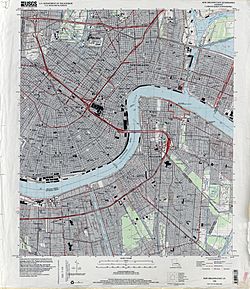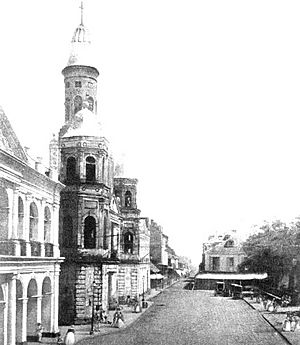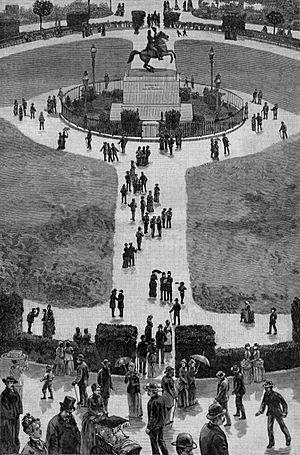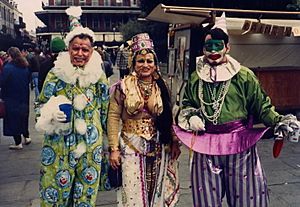Jackson Square (New Orleans) facts for kids
|
Jackson Square
|
|
|
U.S. National Historic Landmark District
Contributing Property |
|
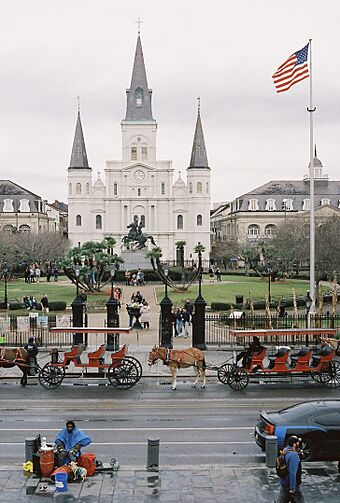
Jackson Square, with Jackson's statue at center, and Saint Louis Cathedral center-back.
|
|
| Location | Bounded by Decatur, St. Peter, St. Ann, and Chartres Sts., New Orleans, Louisiana |
|---|---|
| Area | 2.5 acres (1.0 ha) |
| Built | 1721 |
| Part of | Vieux Carre Historic District (ID66000377) |
| NRHP reference No. | 66000375 |
Quick facts for kids Significant dates |
|
| Added to NRHP | October 15, 1966 |
| Designated NHL | October 9, 1960 |
| Designated NHLDCP | December 21, 1965 |
Jackson Square is a famous historic park in the French Quarter of New Orleans, Louisiana. It was once called the Place d'Armes (French) or Plaza de Armas (Spanish). This park is very important to the city's history.
In 1803, a big event happened here. Louisiana officially became part of the United States because of the Louisiana Purchase. Because of its history, Jackson Square was named a National Historic Landmark in 1960. In 2012, it was also called one of the Great Public Spaces in the United States.
Contents
Designing Jackson Square
Jackson Square was planned to look like the famous Place des Vosges in Paris, France. An architect named Louis H. Pilié designed it. The park is about the size of one city block.
The Andrew Jackson Statue
In 1856, a large statue of Andrew Jackson was placed in the center of the square. Jackson was a hero of the Battle of New Orleans and the seventh U.S. president. The park was named after him. The statue shows him riding a horse. It was made by a sculptor named Clark Mills.
Park Features and Buildings
The park still has its original iron fences, walkways, and benches. The landscaping was designed by Micaela Almonester, Baroness de Pontalba in 1851. She also built the Pontalba Buildings. These are two large, matching buildings that stand on either side of the square.
A flagpole in the square reminds everyone of Louisiana's history. It shows the time when Louisiana was transferred from Spain to France, and then from France to the United States in 1803. This shows Louisiana's rich past as a colony.
In the 1930s, the Works Progress Administration (WPA) helped improve the park. They repainted buildings and made the landscaping better. In 1971, the streets around Jackson Square were closed to cars. This made the area a safe place for people to walk and enjoy.
Jackson Square's History
When the French first settled New Orleans, this area was called the Place d'Armes. This means "weapons' square." Later, when the Spanish controlled the area, it was called Plaza de Armas.
After the Battle of New Orleans in 1815, the military plaza was renamed Jackson Square. This honored General Andrew Jackson, who won the battle. The large statue of Andrew Jackson was put up in 1856. There are also four older statues in the square. They represent the four seasons.
The Mississippi River View
The square used to have a clear view of the Mississippi River. But in the 1800s, tall levees were built. These levees blocked the view. The riverfront was used for shipping. Later, a scenic walkway was built on top of the levee. It is called the "Moon Walk" and lets people enjoy the river view again. The area between Decatur Street and the "Moon Walk" is called "Washington Artillery Park."
Important Buildings Around the Square
On the north side of Jackson Square are three very old buildings. They were the most important buildings in the city during colonial times.
- The middle building is St. Louis Cathedral. It is a beautiful church.
- To the left of the cathedral is the Cabildo. This was the old city hall. Today, it is a museum. The final agreement for the Louisiana Purchase was signed here.
- To the right of the cathedral is the Presbytère. It was built to look like the Cabildo. It was first planned for priests. Later, it became a courthouse and then a museum.
Historical Events at the Square
In the past, Jackson Square was a place for important public gatherings. It was also used for official events. During the Reconstruction Era, Jackson Square was used as a place to store weapons.
Artists, Musicians, and Performers
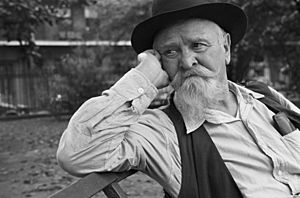
From the 1920s to the 1980s, Jackson Square was famous for its artists. Many painters, from professionals to students, would gather here. They would paint pictures and draw caricatures (funny drawings of people).
Since the 1960s, the square has also become a place for fortune tellers. They read palms and tarot cards. They often sit on St. Ann or St. Peter street, next to the park.
The area in front of the cathedral, the Presbytère, and the Cabildo is busy with visitors. You can also find artists, musicians, and street performers here. Jugglers and magicians often entertain the crowds. These performers usually work for tips.
Things to See and Do
On the other two sides of the square are the Pontalba Buildings. These are red-brick buildings built in the 1840s. The ground floors have shops and restaurants. The upper floors are apartments. These are the oldest apartments in North America that have been rented continuously.
Across Decatur Street from Jackson Square is the Jax Brewery building. This used to be a brewery for a local beer. Now, it has restaurants and shops. Some parts have even been turned into fancy apartments.
Also across Decatur Street is Café du Monde. This famous cafe is open 24 hours a day. It is part of the historic French Market. Café du Monde is known for its café au lait (coffee with milk) and its beignets (fried dough with powdered sugar). They have been serving them since the Civil War.
Jackson Square has hosted many live music events. Every year, the square holds the French Quarter Festival. It also hosts "Caroling in Jackson Square" during the holidays. Sometimes, formal concerts are held in the park.
Jackson Square in Media
Jackson Square has been shown in many TV shows and movies. Some movies include Angel Heart and The Curious Case of Benjamin Button. TV shows like Treme and The Originals have also filmed here.
It is also featured in the graphic novel Polly and the Pirates. In the Star Trek: Deep Space Nine episode "Image in the Sand", a character mentions meeting his wife in Jackson Square. The park is also a very important place in the computer game Gabriel Knight: Sins of the Fathers. Many parts of the game happen there.
On Dick Clark's New Year's Rockin' Eve '17 with Ryan Seacrest, Jackson Square was shown ringing in the new year. This was the first time it was part of the broadcast. A Fleur-de-lis (a symbol of Louisiana) was dropped at midnight Central Time.
See also
 In Spanish: Plaza Jackson para niños
In Spanish: Plaza Jackson para niños


